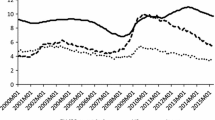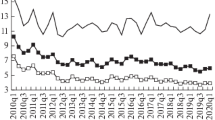Abstract
This study examines the presence of asymmetry in Okun's law for nine transition economies by means of a Markov regime-switching model. We examine the relationship between unemployment and real GDP to ascertain whether such changes are substantially different in downswing versus upswing regimes. The nonlinear model outperforms the linear model in all transition economies in the sample except for Slovenia. There is evidence that the Okun coefficients vary across regimes and countries. In most countries, cyclical unemployment is more sensitive to cyclical output in downswing regimzes than upswing regimes. We also find recoveries entail poor job growth in most transition economies.










Similar content being viewed by others
Notes
We thank Josef Brada for pointing out the possibility of a secular trend in unemployment during transition.
The identification of regimes is an important issue within a Markov regime-switching framework. Studies on Okun's law generally identify the regimes as ‘expansion’ and ‘contraction’ (Harris and Silverstone, 2001; Huang and Chang, 2005; Holmes and Silverstone, 2006). Malley and Molana (2008) identify the regimes as ‘high effort’ in which the unemployment rate is above the natural rate and ‘low effort’ in which unemployment rate is under the natural rate. Harris and Silverstone (2001) label the regimes as ‘upturn in business cycle’ and ‘downturn in business cycle’. While examining the asymmetric nature of the output–unemployment relationship, Silvapulle et al. (2004) use the upswing /downswing terminology. We follow suit and identify the regimes as ‘upswing in the economy’ and ‘downswing in the economy’, respectively.
Although a large number of studies examines linearity in the literature, these studies have computational difficulties; see, for example, Hansen (1992), Garcia (1998) and Cho and White (2007). Therefore, several studies in the literature use the LR test to compare results of the linear and the regime-switching model.
We use a Wald test to determine whether Okun coefficients are statistically different across regimes for all countries. We can reject the null hypothesis that Okun coefficients are statistically equal across regimes at the 5% level for the Czech Republic, Hungary, Latvia and Russia. The test results are available upon request.
Onaran (2008) finds positive but low output elasticity of labor demand in Central and Eastern Europe with a number of cases where employment is completely detached from output. Boeri and Garibaldi (2006) found that the elasticity of employment with respect to output growth is 0.1 in Eastern European members of the EU, way below the Eurozone.
Strictly speaking, the unemployment rate might be falling when the economy experiences job losses. Moreover, unemployment can remain high when the economy adds jobs as labor market adjustments can take other forms such as migration, changes in labor force participation and transitions between the ‘grey economy’ and the ‘formal economy’ where workers are afforded legal protections.
References
Adanu, K . 2005: A cross-province comparison of Okun's coefficient for Canada. Applied Economics 37 (5): 561–570.
Babecky, J, Du Caju, P, Kosma, T, Lawless, M, Messina, J and Room, T . 2010: Downward nominal and real wage rigidity: Survey evidence from European firms. Scandinavian Journal of Economics 112 (4): 884–910.
Basu, S, Estrin, S and Svejnar, J . 2005: Employment determination in enterprises under communism and in transition: Evidence from Central Europe. Industrial and Labor Relations Review 58 (3): 353–369.
Boeri, T . 2000: Structural Change, Welfare Systems and Labour Reallocation. Oxford University Press: Oxford.
Boeri, T and Garibaldi, T . 2006: Are labour markets in the new member states sufficiently flexible for EMU? Journal of Banking & Finance 30 (5): 1393–1407.
Cho, J and White, H . 2007: Testing for regime switching. Econometrica 75 (6): 1671–1720.
Clements, MP and Krolzig, H-M . 1998: A comparison of the forecast performance of Markov-switching and threshold autoregressive models of US GNP. Econometrics Journal 1 (1): 47–75.
Cuaresma, JC . 2003: Okun's law revisited. Oxford Bulletin of Economics and Statistics 65 (4): 439–451.
Davies, RB . 1987: Hypothesis testing when the nuisance parameter is present only under the alternative. Biometrika 74 (1): 33–43.
Dickey, DA and Fuller, WA . 1979: Distribution of the estimators for autoregressive time series with a unit root. Journal of the American Statistical Association 74 (366): 427–431.
Gabrisch, H and Buscher, H . 2006: The relationship between unemployment and output in post-communist countries. Post-Communist Economies 18 (3): 261–276.
Garcia, R . 1998: Asymptotic null distribution of the likelihood ratio test in Markov switching models. International Economic Review 39 (3): 763–788.
Gomme, P . 1999: Shirking, unemployment and aggregate fluctuations. International Economic Review 40 (1): 3–21.
Hamilton, JD . 1994: Time series analysis. Princeton University Press: Princeton, NJ.
Hansen, B . 1992: The likelihood ratio test under non-standard conditions: Testing the Markov switching model of GNP. Journal of Applied Econometrics 7 (S1): 61–82.
Harris, R and Silverstone, B . 2001: Testing for asymmetry in Okun's law: A cross-country comparison. Economics Bulletin 5 (2): 1–13.
Hodrick, RJ and Prescott, EC . 1997: Postwar US business cycles: An empirical investigation. Journal of Money, Credit and Banking 29 (1): 1–16.
Holmes, MJ and Silverstone, B . 2006: Okun's law, asymmetries and jobless recoveries in the United States: A Markov-switching approach. Economics Letters 92 (2): 293–299.
Huang, H and Chang, Y . 2005: Investigating Okun's law by the structural break with threshold approach: Evidence from Canada. The Manchester School 73 (5): 599–611.
Huang, H and Lin, S . 2006: A flexible nonlinear inference to Okun's relationship. Applied Economics Letters 13 (2): 325–331.
Huang, H and Lin, S . 2008: Smooth-time-varying Okun's coefficients. Economic Modelling 25 (5): 363–375.
Izyumov, A and Vahaly, J . 2002: The unemployment–output tradeoff in transition economies: Does Okun's law apply? Economics of Planning 35 (4): 317–331.
Krolzig, H . 1997: Markov-Switching Vector Autoregressions Modeling, Statistical Inference, and Application to Business Cycle Analysis. Springer: Berlin.
Lee, J . 2000: The robustness of Okun's law: Evidence from OECD countries. Journal of Macroeconomics 22 (2): 331–356.
Lehmann, H and Muravyev, A . 2011: Labor markets and labor market institutions in transition economies. IZA Discussion Paper No. 5905, August, IZA: Bonn.
Malley, J and Molana, H . 2008: Output, unemployment and Okun's law: Some evidence from the G7. Economics Letters 101 (2): 113–115.
Mise, E, Kim, TH and Newbold, P . 2005: On the sub-optimality of the Hodrick-Prescott filter. Journal of Macroeconomics 27 (1): 53–67.
Moosa, IA . 1997: A cross-country comparison of Okun's Coefficient. Journal of Comparative Economics 24 (3): 335–356.
Neftci, SN . 1984: Are economic time series asymmetric over the business cycle? Journal of Political Economy 92 (2): 307–318.
Okun, AM . 1962: Potential GNP: Its measurement and significance. Proceedings of the Business and Economic Statistics Section of the American Statistical Association: 98–104.
Onaran, Ö . 2008: Jobless growth in the Central and Eastern European Countries: A country specific panel data analysis for the manufacturing industry. Eastern European Economics 46 (4): 90–115.
Pedersen, TM . 2001: The Hodrick–Prescott filter, the Slutzky effect, and the distortionary effect of filters. Journal of Economic Dynamics and Control 25 (8): 1081–1101.
Perman, R and Tavera, C . 2005: A cross-country analysis of the Okun's law coefficient convergence in Europe. Applied Economics 37 (21): 2501–2513.
Rand, J and Tarp, F . 2002: Business cycles in developing countries: Are they different? World Development 30 (12): 2071–2088.
Schettkat, R . 1996: Labor market flows over the business cycle: An asymmetric hiring cost explanation. Journal of Institutional and Theoretical Economics 152 (4): 641–653.
Schiff, JA, Egoumé-Bossogo, P, Ihare, P, Konuki, T and Krajnyák, K . 2006: Labor market performance in transition: The experience of Central and Eastern European countries. IMF Occasional Paper No. 248, July, IMF: Washington DC.
Silvapulle, P, Moosa, IA and Silvapulle, MJ . 2004: Asymmetry in Okun's law. Canadian Journal of Economics 37 (2): 353–374.
Sögner, L . 2001: Okun's law. Does the Austrian unemployment-GDP relationship exhibit structural breaks? Empirical Economics 26 (3): 553–564.
Svejnar, J . 1999: Labour markets in the transitional Central and Eastern European Economies. In: Ashenfeldter, O and Card, D (eds). Handbook of Labour Economics Vol. 3–4, Elsevier Science: North Holland, Amsterdam, pp. 2809–2857.
Villaverde, J and Maza, A . 2009: The robustness of Okun's law in Spain, 1980–2004: Regional evidence. Journal of Policy Modeling 31 (2): 289–297.
Viren, M . 2001: The Okun curve is non-linear. Economics Letters 70 (2): 253–257.
Weber, CE . 1995: Cyclical output, cyclical unemployment, and Okun's coefficient: A new approach. Journal of Applied Econometrics 10 (4): 433–455.
Acknowledgements
We thank the editor, Josef Brada, and two anonymous referees for comments that led to significant improvements in the article. We are solely responsible for any remaining errors.
Author information
Authors and Affiliations
Rights and permissions
About this article
Cite this article
Cevik, E., Dibooglu, S. & Barişik, S. Asymmetry in the Unemployment–Output Relationship Over the Business Cycle: Evidence from Transition Economies. Comp Econ Stud 55, 557–581 (2013). https://doi.org/10.1057/ces.2013.7
Published:
Issue Date:
DOI: https://doi.org/10.1057/ces.2013.7




